
Best Coconut Aminos
Made from coconut sap, coconut aminos is a savory sauce that's commonly used as a lower-sodium substitute for soy sauce. Although most consider it to be a bit sweeter than soy sauce, it shares a similar color and texture, and so is often used in recipes or seasonings that call for soy sauce. Coconut aminos is typically made with just a few ingredients - coconut blossom nectar (also known as coconut sap) and salt chief among them - and is free of gluten and soy. While that explains the first half of the name - coconut - the second half comes from the fact that most coconut aminos products contain up to 17 types of amino acids. However, someone would have to ingest an outrageously large amount of coconut aminos to really reap any nutritional benefits from these amino acids.
For many, a big draw of coconut aminos over soy sauce is its comparatively low sodium content. While a teaspoon of soy sauce typically contains close to 300mg of sodium, the same amount of coconut aminos typically has somewhere between 90 and 150mg of sodium, depending on the brand. We rounded up some of the best coconut aminos on the market and gave our picks.
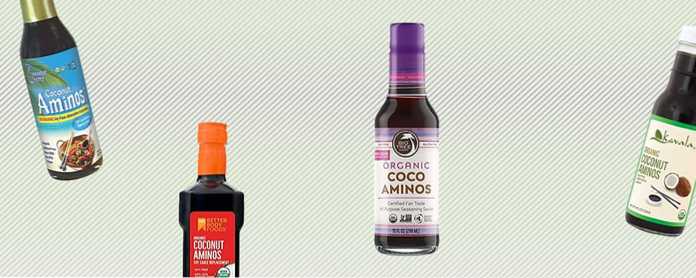
Editors' Choice:
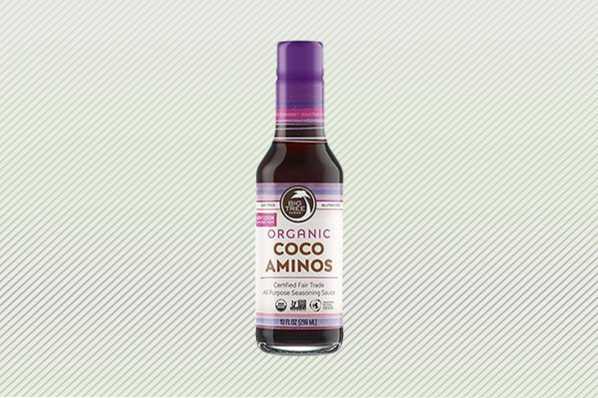
Big Tree Farms Coco Aminos
Pros:
- Big Tree Farms Coco Aminos is made with certified organic and fairtrade coconuts harvested by hand in Indonesia, where the company is based.
- Available in three flavors - Original, Gingery Lime, and Tangy BBQ.
- The only ingredients used in the original Coco Aminos flavor are coconut blossom nectar, water, and sea salt. Gingery Lime and Tangy BBQ include additional ingredients for flavoring.
- Company works with over 14,000 local farmers in Indonesia, and touts their sustainable growing practices as well as fair business dealings as a key component of their business.
Cons:
- At 160mg sodium per serving, this coconut aminos is a bit higher in sodium than some of the competitors.
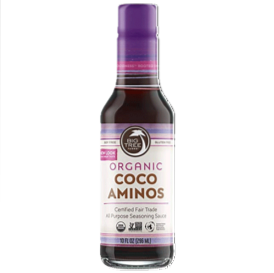
Made from certified organic and fair trade coconuts from Indonesia, Big Tree Farms Coco Aminos may be a great option for folks looking for a soy sauce alternative. Big Tree Farms touts its product as being brewed in small batches to maintain flavor and nutrition profile.
Shop AmazonBest Bulk Option:
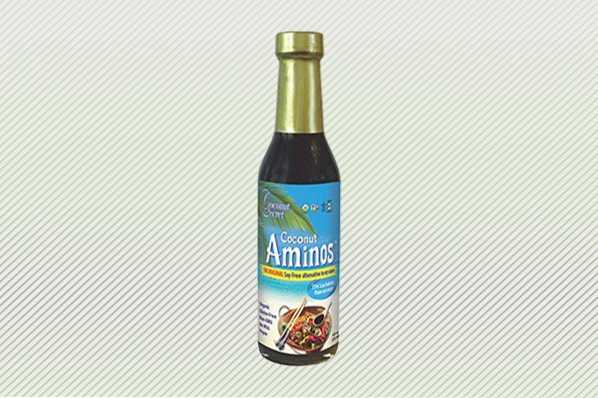
Coconut Secret Coconut Aminos
Pros:
- Each 1tsp serving of Coconut Secret Coconut Aminos includes 113mg of sodium.
- Coconut Secret Coconut Aminos is made with just two ingredients, coconut sap and sea salt, making it gluten and soy free.
- The manufacturer touts the sustainable farming practices used by their farmers in the Philippines.
- On a cost per serving basis, this is one of the more affordable coconut aminos products on the market.
Cons:
- While this large container may be great for chefs who cook in large quantities, for smaller home use, the wide mouth from which the coconut aminos is poured may be a bit unwieldy.
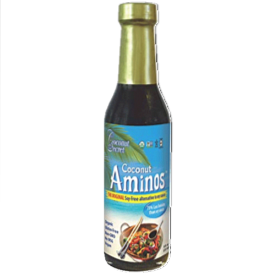
Coconut Secret Coconut Aminos is made with only two ingredients: coconut sap and sea salt. Available in large quantities at a very reasonable price point, this may be a great addition to any kitchen that utilizes soy sauce frequently, and is looking to cut back on sodium.
Shop AmazonContender:
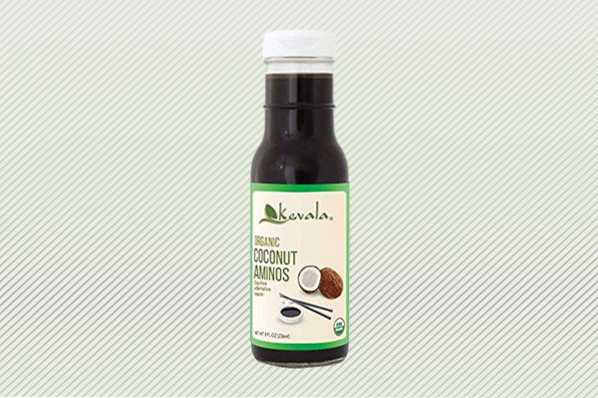
Kevala Organic Coconut Aminos
Pros:
- Kevala Organic Coconut Aminos is made from organic coconut nectar, organic pure coconut blossom sap, and sea salt, making it gluten and soy free.
- Each tsp sized serving contains 136mg of sodium, considerably less than the average amount of sodium in soy sauce.
- The organic coconut nectar gives this coconut aminos a slightly sweet flavor profile, while the sea salt makes it a viable alternative for soy sauce in many recipes.
Cons:
- On a cost per serving basis, this ranks as among the more expensive coconut aminos products on the market.
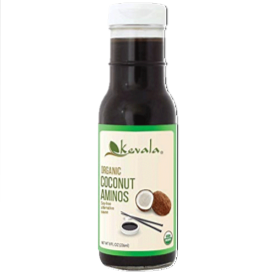
For folks looking for a slightly sweet, but ultimately savory soy sauce substitute, Kevala Organic Coconut Aminos may be worth considering. Made with organic ingredients, this coconut aminos contains 136mg sodium per tsp serving.
Shop AmazonAlso Consider:
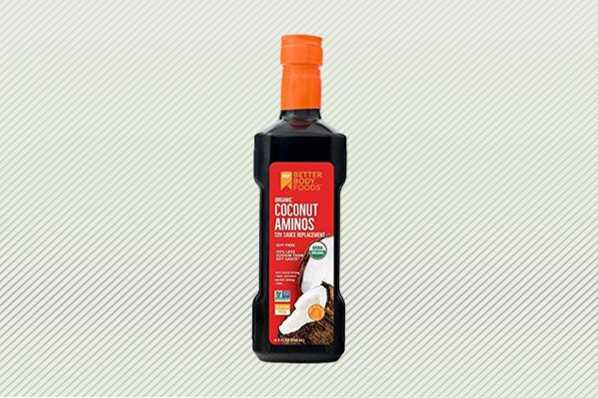
Better Body Foods Organic Coconut Aminos
Pros:
- Better Body Foods makes their organic coconut aminos with non GMO products.
- Made with organic coconut blossom nectar and Himalayan salt.
- Compared to the average sodium levels of soy sauce, this ingredient contains 45% less sodium.
Cons:
- Compared to some other coconut aminos on the market, Better Body Foods has a bit more sodium per serving.
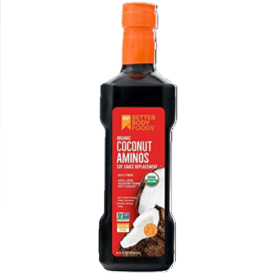
Better Body Foods offers an organic coconut aminos that's intended to be a stand-in for soy sauce in many recipes. While its sodium levels are a bit higher than some competing coconut aminos, at 160mg per tsp it still checks in far lower than soy sauce.
Shop AmazonMethodology
Coconut aminos is an increasingly popular sauce that many use as a low sodium substitute for soy sauce. Typically made from the fermented sap from coconut flower blossoms and salt, it is naturally gluten and soy free, making it a popular choice for folks following paleo, keto, or Whole 30 style diets. With this in mind, there are a few key features to consider when selecting coconut aminos.
Sodium
For a lot of folks, a driving factor behind switching from soy sauce to coconut aminos is to cut down on sodium. While the average tsp size serving of soy sauce contains close to 300mg of sodium, the same amount of coconut aminos contains anywhere between 90 and 160mg sodium, depending on the brand.
Bottle Type
This biggest difference here is plastic vs. glass. This ultimately comes down to personal preference; while some prefer the clumsiness afforded by plastic, others prefer having their sauces in glass containers.
Size
Before clicking purchase, take a look at the size of the bottle. Those who regularly use coconut aminos as they cook large meals may prefer a gallon sized container, while folks who only use it sparingly will be better off with an 8 or 10 oz bottle. It's important to note that this sauce should be refrigerated after being opened.
Ingredients
Typically, coconut aminos is only made from coconut sap (sometimes referred to as coconut blossom nectar) and salt. Take a look at the ingredients list - if there are additional items listed, it may be a red flag.
FAQ
Do coconut aminos taste like soy sauce?
Coconut aminos have a very similar texture and color to light soy sauce. While it's a bit sweeter than soy sauce, it does not taste like coconuts, and many use it as a soy sauce substitute.
Are coconut aminos bad for you?
For a lot of folks, coconut aminos is a terrific low sodium, gluten-free substitute for soy sauce. However, folks with coconut allergies should certainly steer clear.
What is in coconut aminos?
Coconut aminos is usually made up of just two ingredients: coconut sap and salt. Coconut sap is harvested from the flowers of a coconut tree, and is sometimes referred to as coconut blossom nectar or coconut blossom sap.
Do you have to refrigerate coconut aminos?
Like many condiments, once coconut aminos has been opened, it should be refrigerated to maintain freshness. When in doubt, check the labeling and follow those instructions.
BarBend Tips
- If transitioning from soy sauce to coconut aminos, it may be wise to start with a small bottle, just to ensure your tastebuds are amenable.
- Coconut aminos can be used in a variety of ways! Try it out in different marinades, dressings, and stir-fries.
Coconut aminos is commonly used as a lower-sodium alternative to soy sauce. Though a bit sweeter than soy sauce, its similar texture, color, and taste profile make it a naturally gluten-free substitute.



Nimeni nu a comentat acest articol încă.